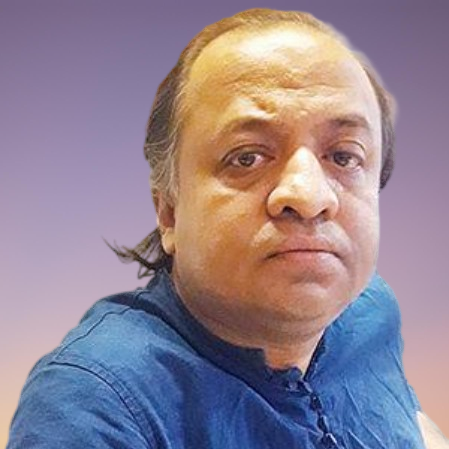Culture

I was first introduced to West Bengal poet Samarendra Sen Gupta at poet Professor Muhammad Samad's residence at Dhaka University teachers' quarters in 2010. He wore a khaddar panjabi and carried a bag. His pleasant personality was easily expressed through his softness of speech and cool temperament. During that year, Gupta visited Dhaka to participate in the National Poetry Festival. On that evening, poets Mahadev Saha, Nirmalendu Goon, Habibullah Shirazi, late Rabiul Husain and a number of writers sat together and conversed on many contemporary issues. Gupta, however, was a little silent and fortunately I sat beside him. Sometimes I talked to him about his childhood, poetry and his becoming a poet. He could be articulate.
With his passing, we have lost one of the leading contemporary poets of Bengali literature, one who truly projected our lives, nature, reflections and contemplations of life. Most of his poems have a great touch of modernity. Gupta was one of the poets who is deeply rooted in his own tradition, culture and surrounding atmospheres. He immerses the language of our times, exceeding the limits of geography. Needless to say, the poet built on the ground of the 40s poets, but he has developed the ground, explored into areas they thought too dark for exploration, has added new features to it, landscaped it and in the process left his footprints all over. He offers us the kind of poetry that successfully denote a wide range of middle-class experiences, while making some politically significant inter-class connections in the interest of enlivening and inspiring broad-based struggles against oppression and injustice.
Gupta was born in Dhaka in 1935 and spent the first sixteen years of his life here before moving to Calcutta (now Kolkata) in 1951. He was a student of Pirenonath High School (now Nawabpur High School). He passed his matriculation in 1951 from the same institute and migrated to Calcutta the same year. After settling in Calcutta, he became involved in left-wing politics.
Gupta remembered life as it was in Dhaka. As he noted, "Dhaka life was very vivid and colourful. The city was expanded focusing on Old Dhaka. The population of Dacca was not large. We lived in a big house in Purana Paltan. The house had a touch of aristocracy. The rose garden in our house was famous in the city at the time. Lots of level-headed persons used to come to our house, especially for the garden. My father was the registrar of Dhaka University. We had quite a few eminent neighbours, like Jasimuddin, Mohitlal Majumdar, Ramesh Chandra Mazumdar and more. Most of the people who lived in our area were Hindus. Most of them were involved with Dhaka University."
Gupta continued: "At the time, riots were a regular feature in Dhaka and people lived in anxiety. There would be a number of riots every year around the time of Durga Puja, Janmashtami, Muharram or other religious festivals. The common people were very helpless. Influential people led these illicit activities.
"After 1947, the situation started deteriorating rapidly and most of our Hindu neighbours started selling their houses and migrated to India. Hindus felt very insecure. My family migrated to Calcutta in 1951."
Gupta began writing in 1956-1957. His first write-up was published in his college magazine. Afterwards, the legendary author Premendra Mitra requested him to write for his literary journal. The journal was very prominent during that period. In his career, Gupta worked for Anandabazar's Ochena Shahor from 1958 to 1959. Once he worked for the Kolkata Korcha where Sunil Gangopadhyay, Shyamol Gangopadhyay and Shirshendu Mukhopadhyay were his colleagues. Then he wrote for many literary journals and poetry quarterlies. Once he even worked as a sales executive for East India Pharmaceuticals.
Gupta is generally a modernist poet. He is also a prolific poet and his poems are of outstanding intellectual quality. Incidents of everyday life can be found in much of his poetry. He frequently experiments with form and content. He often approaches surrealism and expressionism in his works. He uses the imagery of the moon, sun, sky, lush greenery, clouds and other natural wonders in his poetry. His poetry shows a considerable degree of social awareness and a sense of satire. His works also focus on Kolkata's contemporary life and times.
Gupta has authored around twenty four compilations of poetry, literary criticism, and travel literature. His Gachh Manush was selected for translation in French. As a translator of repute, he was actively connected with National Book Trust of which he was a committee member and also related with Sahitya Academy as research fellow. He also translated the American Poetry Chapter in the "Shapta Sindhu Desh Diganta" collection. Some of his notable poetry books are "Amar Samay Olpo", "Coffee Houser Shiri", "Desh Amar Shadesh", "Charidike Prithibi", "Khola Kolom-er Pashe", "Chhobir Shobdo" and more. He was the recipient of several prestigious awards -- Sahitya Academy Puroshkar, Rabindra Puroshkar, Vishnu Dey Puroshkar being a few.
The writer is an art critic and cultural curator.

























Leave a Comment
Recent Posts
Right On Schedule
The most eagerly anticipated, and frankly hyped up, announcement of an ...
Fighting raged along the borde ...
Fighting raged along the border of Cambodia and Thailand, with explosi ...
ICIMOD drives regional cooperation to inspire new mo ..
The Cage of Captivity and the Cry for Freedom: A Cru ..
Why Japan issued an advisory for a possible megaquak ..
The Autocrats’ War on Universities